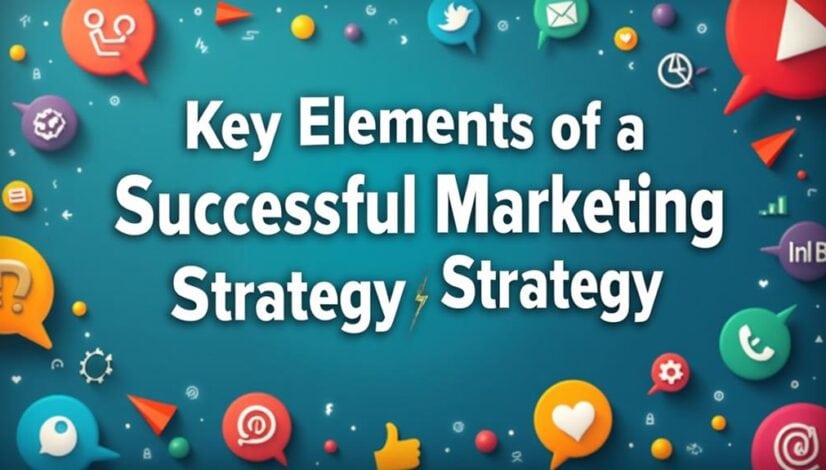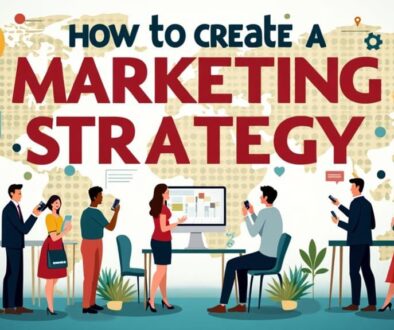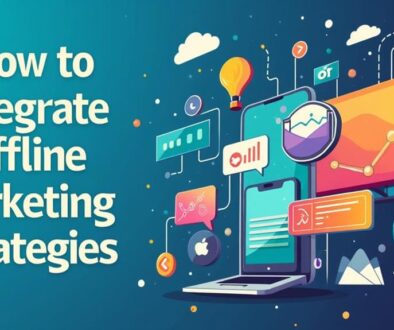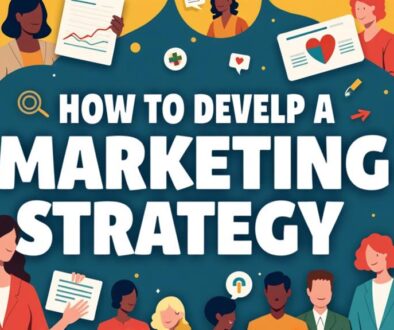Key Elements of a Successful Marketing Strategy for SMBs
A successful marketing strategy for small and medium-sized businesses (SMBs) revolves around several essential elements. First, defining a target audience through demographic and psychographic insights is vital. Next, crafting a unique value proposition that highlights what sets the business apart can effectively address customer pain points. Selecting appropriate marketing channels and setting measurable goals using the SMART framework enhances accountability. Additionally, effective budgeting guarantees peak resource allocation, while consistent branding fosters recognition and loyalty. Utilizing data analytics and engaging with customer feedback allow for agile adaptations to market changes, laying the groundwork for sustained business growth. Explore further to uncover additional strategies.
Key Takeaways
- Identify and understand your target audience through demographic, psychographic, and behavior analysis to tailor marketing strategies effectively.
- Develop a unique value proposition (UVP) that highlights what differentiates your business and addresses customer pain points.
- Select appropriate marketing channels to reach your audience, ensuring engagement and effective content distribution.
- Set measurable goals using the SMART framework to track progress and adapt strategies based on market dynamics.
- Build a consistent brand identity that fosters customer loyalty through cohesive messaging and visual elements across all platforms.
Defining Your Target Audience

Identifying your target audience is pivotal for driving effective marketing strategies in small and medium-sized businesses (SMBs). By developing customer personas, companies can craft detailed representations of their ideal consumers, facilitating targeted messaging and outreach. These personas should emerge from thorough demographic analysis, which includes age, gender, income, and location, enabling businesses to understand who their customers are and what they desire.
Moreover, psychographic segmentation enhances this understanding by delving deeper into lifestyle choices, values, and interests. Such insights are invaluable; they permit businesses to create communications that resonate on a more personal level, fostering genuine audience engagement.
Behavior tracking further refines this process, allowing SMBs to analyze customer interactions and preferences, thereby tailoring their approaches in real-time.
In addition, effective market research is essential for illuminating socio-economic factors that influence purchasing decisions. This extensive evaluation aids SMBs in honing their niche targeting strategies, ensuring that marketing efforts reach the most promising demographic segments.
Businesses must recognize that a one-size-fits-all approach is futile; hence, granular insights lead to higher conversion rates and sustained customer loyalty.
Ultimately, defining your target audience is not merely a task; it is a strategic imperative that informs every facet of marketing efforts. When executed with precision and creativity, it grants SMBs the freedom to connect authentically with their clientele, driving growth and long-term success in an increasingly competitive marketplace. By leveraging advanced tools and data-driven insights, businesses can tailor their messages and offerings to resonate deeply with their ideal customers. One powerful way to boost SMB marketing with AI is by utilizing artificial intelligence to analyze customer behavior, segment audiences, and generate personalized campaigns at scale. This innovative approach not only enhances efficiency but also fosters stronger, more meaningful relationships with consumers.
Crafting a Unique Value Proposition
Once a business has a clear understanding of its target audience, the next step involves formulating a unique value proposition (UVP) that distinctly communicates what sets it apart in the marketplace. A well-crafted UVP should address specific customer pain points, presenting a compelling reason for potential clients to choose your offering over competitors.
To effectively articulate a UVP, it is essential to explore deeply into the nuances of your customers’ needs and struggles. By identifying and empathizing with their pain points, businesses can tailor their messaging to resonate emotionally, forging a connection that fosters loyalty and trust. For instance, if your target audience grapples with time constraints, emphasizing efficiency and convenience in your offerings can greatly enhance your UVP.
Moreover, competitive differentiation is a crucial aspect of a strong UVP. It requires analyzing competitors not merely to replicate their strategies but to identify the unique strengths that distinguish your business. This could include superior product features, exceptional customer service, or an innovative business model. By showcasing these distinctive elements, your UVP becomes a beacon, illuminating the path toward customer engagement and retention.
Ultimately, a unique value proposition is more than just a marketing statement; it is an articulation of your brand’s essence. It encapsulates your mission, values, and the extraordinary solutions you provide.
Mastering the art of crafting a UVP empowers SMBs to freely navigate the competitive landscape, ensuring sustained growth and success.
Selecting Marketing Channels
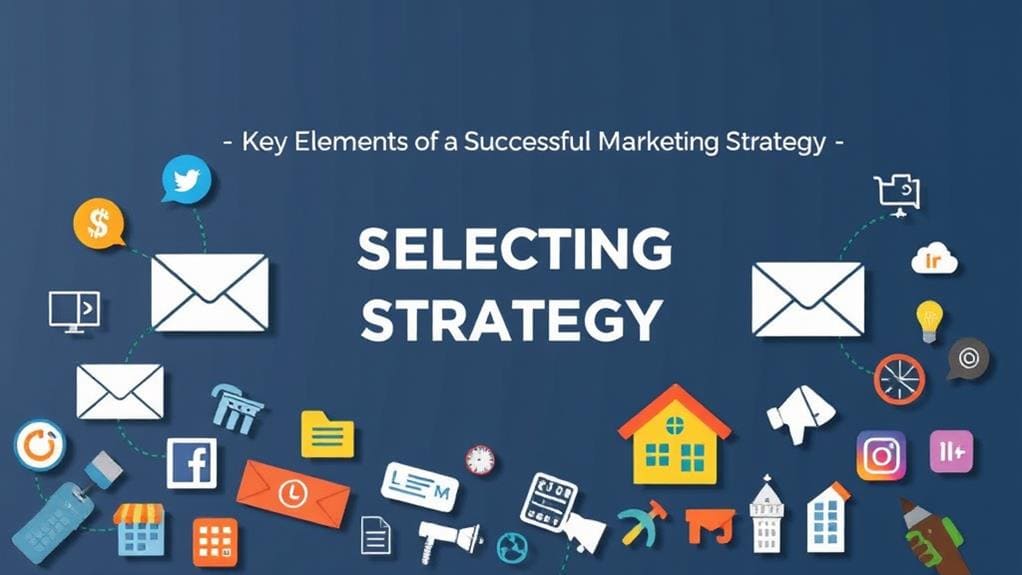
In the quest for effective marketing, selecting the right channels can considerably influence an SMB’s ability to connect with its target audience. With an array of digital platforms at their disposal, businesses must strategically navigate these options to maximize channel effectiveness.
Understanding the nuances of audience segmentation is crucial; this tailored approach guarantees that marketing efforts reach the right consumers with the right messages.
Content distribution is a critical consideration in this selection process. Platforms that facilitate social engagement, such as Instagram, Facebook, and LinkedIn, provide dynamic ecosystems for storytelling and brand interaction. Here, outreach strategies can be intensified through influencer partnerships, leveraging trusted figures to enhance credibility and expand reach.
In an ever-evolving landscape characterized by swift marketing trends, the agility to experiment with diverse advertising options—ranging from pay-per-click to sponsored content—becomes essential.
Each channel must be measured against performance metrics to evaluate its impact on the overall strategy. Regular assessment allows SMBs to pivot and optimize resources effectively.
Setting Measurable Goals
Establishing a clear set of measurable goals is an essential next step following the careful selection of marketing channels. Without measurable goals, businesses lack direction and accountability, which hinders their potential for success.
By integrating goal tracking and performance metrics into your strategy, you can transform abstract aspirations into concrete outcomes, enabling your small to medium-sized business (SMB) to thrive.
To effectively set measurable goals, consider the following three aspects:
- SMART Framework: Confirm that your goals are Specific, Measurable, Achievable, Relevant, and Time-bound. This captures clarity while fostering a sense of freedom in target execution.
- Define Key Performance Indicators (KPIs): Identify specific metrics that will accurately reflect your performance against established goals. Examples include website traffic, conversion rates, or customer acquisition cost—each serving as a compass guiding you to your desired destination.
- Regular Review and Adjustment: Establish a schedule for reviewing your performance metrics. Flexibility is essential; the business landscape is dynamic, and the ability to pivot in response to new data can reveal opportunities for growth.
Budgeting for Marketing Efforts

Effectively budgeting for marketing efforts is vital for the sustainability and growth of small to medium-sized businesses (SMBs). A well-structured budget not only sets the financial course for marketing initiatives but also allows for prudent resource allocation, enabling businesses to flexibly adapt to changing market conditions.
To thrive in a competitive landscape, SMBs must prioritize cost-effective strategies that deliver measurable results without overextending their financial resources.
The first step in successful budgeting involves evaluating the overall financial health of the business. This includes identifying available capital and determining how much can be reasonably allocated to marketing. A typical guideline suggests that SMBs allocate anywhere from 5% to 10% of their revenue for marketing purposes, but this can vary based on industry and growth stage.
Once a clear budget is established, the next task is to evaluate and select marketing channels that align with both the target audience and available resources.
Digital marketing offers a range of cost-effective strategies, from social media advertising to content marketing, allowing SMBs to reach audiences without the hefty price tag of traditional marketing methods.
It is essential to continuously analyze the performance of selected strategies and reallocate resources as necessary to maximize ROI. By maintaining flexibility in their budgeting process and focusing on cost-efficient initiatives, SMBs can guarantee they remain competitive, achieve their growth objectives, and ultimately embrace the freedom that comes with financial sustainability.
Creating Consistent Branding
A cohesive and recognizable brand identity serves as a cornerstone for small to medium-sized businesses (SMBs) looking to differentiate themselves in crowded markets. By establishing consistent branding, SMBs not only improve audience perception but also foster emotional connections that drive loyalty.
To create a compelling brand identity, businesses should focus on the following three elements:
- Visual Identity: This includes logo design, color psychology, and typography, all of which must align with the desired brand positioning. A well-crafted visual identity serves as a quick recognition tool, allowing audiences to connect instantly with your brand.
- Brand Voice: Your messaging consistency is vital in how your audience perceives your brand. Developing a distinct brand voice—whether professional, casual, or playful—guarantees that all communications resonate with your target demographic. Consistent language across platforms deepens the emotional connection with customers.
- Brand Guidelines: To maintain consistency across various marketing channels, establishing thorough brand guidelines is essential. These guidelines should encompass visual elements, tone of voice, and storytelling techniques. By adhering to these rules, SMBs can confirm that their branding is not only consistent but also adaptable to different contexts.
Incorporating these elements thoughtfully can greatly enhance how SMBs engage with their audiences and differentiate themselves in a competitive landscape.
Utilizing Data Analytics
Harnessing the power of data analytics has become essential for small to medium-sized businesses (SMBs) endeavoring to optimize their marketing strategies and drive growth. In a landscape saturated with options, businesses that leverage data systematically can reveal invaluable insights into customer behavior, market trends, and campaign performance.
Utilizing predictive analytics tools enables SMBs to forecast future customer actions and tailor their offerings accordingly. By understanding potential buying patterns, businesses can allocate resources more effectively, ensuring they meet customer needs without overextending themselves.
Incorporating data visualization techniques further enhances this approach. Visual representations of complex data sets make it easier to interpret trends and patterns, facilitating informed decision-making. For instance, a well-structured dashboard can quickly show how various marketing efforts influence sales, providing clarity that raw numbers alone cannot deliver. This clarity allows for agile adjustments to campaigns, maximizing return on investment.
Moreover, SMBs must embrace a culture of data-driven decision-making, moving away from intuition-based strategies. By offering team training on analytics tools, businesses can create a collaborative environment where insights lead to innovation. Empowered teams can execute more precise marketing strategies, fine-tuning messages that resonate deeply with target demographics and fostering stronger connections with customers.
Incorporating these practices not only cultivates a foundation of freedom in decision-making but also positions SMBs to thrive in a competitive market. Ultimately, the effective utilization of data analytics emerges as a cornerstone for any SMB seeking sustainable growth and resilience in today’s dynamic economic environment. By harnessing insights from data, SMBs can make informed choices that drive efficiency, innovation, and customer satisfaction. Moreover, exploring the business advantages of AI adoption allows these companies to streamline operations, automate routine tasks, and uncover patterns that might otherwise go unnoticed. This strategic integration of technology ensures that SMBs remain agile and better equipped to navigate uncertainties while staying ahead of the competition.
Engaging With Customer Feedback
Engaging with customer feedback is essential for small and mid-sized businesses, as it not only demonstrates an active commitment to understanding their audience but also paves the way for continuous improvement.
Importance of Listening
Listening, an often undervalued yet essential component of effective marketing, serves as the foundation for meaningful interactions between small and medium-sized businesses (SMBs) and their customers.
By embracing active listening, SMBs can transform customer feedback into valuable customer insights that enhance engagement and elevate brand perception.
Consider these pivotal benefits of prioritizing listening:
- Enhanced User Experience: Listening to customer feedback allows SMBs to identify pain points and improve product or service offerings, leading to a more satisfying user experience.
- Informed Communication Strategies: Effective listening fosters dynamic feedback loops, enabling businesses to adapt their marketing messages based on real-time audience sentiments and market trends.
- Deepened Understanding of Consumer Behavior: Incorporating sentiment analysis tools aids in discerning the preferences and expectations of the target audience, ultimately guiding innovative marketing efforts.
In a world where consumer behavior shapes market dynamics, listeners are not only receivers of feedback but also architects of impactful change.
Implementing Constructive Input
A robust system for implementing constructive input is essential for businesses aiming to capitalize on customer feedback effectively. Engaging with customers through feedback loops allows companies to gather insights that drive innovation and improvement. By initiating collaborative brainstorming sessions, organizations can harness diverse perspectives, transforming feedback into actionable strategies.
Creating an environment where customer voices are valued encourages open dialogue, fostering a culture of continuous improvement. Regularly soliciting feedback, whether through surveys, social media, or face-to-face interactions, establishes a rhythm that keeps the lines of communication alive. Subsequently, the insights gain high relevance, enabling SMBs to refine their offerings in alignment with customer expectations.
Moreover, ensuring that feedback is not only collected but also acted upon is vital. This commitment demonstrates to customers that their opinions matter, cementing the relationship further. When feedback is looped back into the marketing strategy, companies can position themselves as responsive and adaptive, ready to meet customer needs.
In essence, implementing constructive input is a dynamic process that empowers SMBs to leverage customer feedback creatively while nurturing loyal clientele through genuine engagement. The journey towards an agile marketing strategy begins with listening—and responding—effectively.
Building Trust and Loyalty
Customer feedback serves as a foundation for building trust and loyalty among SMBs and their clientele. By actively engaging with customer insights, businesses can enhance their customer relationships and create an emotional connection that fosters brand advocacy.
Employing robust trust-building strategies and loyalty programs not only strengthens community engagement but also positions the brand as a transparent and customer-centric entity.
Consider the following approaches:
- Implement Transparency Practices: Openly share how customer feedback influences decision-making, showcasing a commitment to improvement. This transparency builds trust by demonstrating accountability.
- Leverage Customer Testimonials: Use social proof to showcase positive experiences. Real stories from satisfied customers can greatly enhance credibility and encourage potential clients to engage with your brand.
- Offer Personalized Experiences: Tailor interactions based on feedback. By understanding individual preferences, you can create targeted marketing campaigns that resonate, leading to increased loyalty and repeat business.
Adapting to Market Changes
In today’s rapidly evolving business landscape, the ability of small and medium-sized businesses (SMBs) to adapt to market changes is essential for long-term success. To thrive amidst constant industry disruptions, SMBs must prioritize thorough competitive analysis and stay attuned to emerging market trends. By understanding shifting consumer behavior, they can forge adaptive strategies that resonate with their audiences.
Agile marketing is key in this pursuit, enabling businesses to pivot quickly in response to unforeseen changes. This flexibility allows SMBs to implement innovative approaches that can capture new opportunities, ensuring they remain relevant and competitive.
In addition, proactive planning is imperative; businesses can lay the groundwork for effective adaptation by anticipating potential shifts in the marketplace. Strategic flexibility empowers SMBs to make real-time adjustments to their marketing tactics, allowing them to respond swiftly to both challenges and opportunities. By integrating AI implementation for small businesses, companies can further enhance their ability to interpret market trends and customer behaviors, enabling data-driven decision-making. This technological advancement not only improves efficiency but also opens doors to innovative marketing strategies tailored to specific audience needs. As a result, small businesses can maintain a competitive edge, staying agile in an ever-changing marketplace.
The integration of robust data analytics will enhance their ability to evaluate the performance of their initiatives and refine their strategies accordingly, fostering a culture of continuous improvement.
Ultimately, to foster resilience against the tides of change, SMBs must embrace these adaptive strategies. By doing so, they position themselves not only to survive but to thrive amid uncertainty, cultivating a marketing strategy that is as dynamic as the markets they serve.
In this pursuit of freedom from stagnation, empowered SMBs can release their potential, inspiring confidence among their customers and stakeholders alike.
Frequently Asked Questions
How Often Should I Revise My Marketing Strategy?
Revising your marketing strategy is essential for ensuring its effectiveness in an ever-evolving marketplace.
Conduct regular marketing audits at least biannually to assess performance, identifying areas for improvement and adaptation. Align these audits with specific strategy timelines, allowing for timely adjustments in response to market changes or consumer behavior.
What Is the Role of Storytelling in Marketing?
Storytelling plays a vital role in marketing by fostering customer engagement and brand loyalty through the establishment of an emotional connection.
Utilizing narrative techniques enhances audience targeting and content creation, enabling brands to effectively convey their messages.
Visual storytelling further amplifies this impact, ensuring message consistency across various platforms.
How Can I Effectively Train My Team on Marketing Strategies?
To train your team on marketing strategies, consider the wisdom of the ancient artisans who mastered their crafts through collaboration and shared insights.
Fostering team engagement is paramount; utilize interactive training tools such as workshops and role-playing scenarios.
Encourage open dialogue and feedback to cultivate a culture of learning.
What Are Common Marketing Mistakes to Avoid for Smbs?
Common marketing mistakes that small to medium businesses (SMBs) should avoid include neglecting their target audience during campaign planning, leading to ineffective messaging.
Poor budget allocation can restrict growth, while inadequate digital presence diminishes visibility.
Additionally, low content quality can undermine branding consistency, and a lack of engagement on social media may hinder customer loyalty.
How Do I Balance Short-Term and Long-Term Marketing Goals?
Balancing short-term marketing tactics with a long-term vision requires meticulous goal alignment.
Establish clear performance metrics to evaluate the effectiveness of short-term initiatives while ensuring they support overarching objectives.
Thoughtful resource allocation can facilitate both immediate customer engagement and sustained brand growth.
Conclusion
In the bustling marketplace, a well-crafted marketing strategy serves as a beacon, guiding small and medium-sized businesses toward success. By identifying target audiences, encapsulating unique value propositions, and engaging through diverse channels, these enterprises can weave a rich tapestry of brand recognition and customer loyalty. The continuous dance of data analytics and feedback illuminates the path forward, ensuring adaptability in an ever-evolving landscape. Ultimately, the fusion of creativity and strategy transforms aspirations into lasting impact, resonating deeply within communities.
